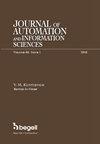空间飞行器角运动的数学模型及其在定向控制问题中的应用
Q3 Engineering
Journal of Automation and Information Sciences
Pub Date : 2021-09-01
DOI:10.34229/1028-0979-2021-5-10
引用次数: 0
摘要
提出了航天器姿态演化运动学方程相对于参考坐标系(RCS)的一般结构。假设坐标系的原点重合,并且位于航天器的任意点。每个坐标系以其轴上的投影指定的任意绝对角速度(相对于惯性空间)旋转。姿态参数可以是Euler–Krylov角、Rodrigues–Hamilton参数和修正的Rodriguez参数。结果表明,使用Rodrigues-Hamilton参数(归一化四元数的分量)的SCS相对于RCS的姿态演化方程的众所周知的表示可以简单地从求解具有给定运动积分的整个微分方程组的Erugin问题中获得。考虑了使用每个指定姿态参数的优点和缺点。提出了一种姿态控制综合方法,该方法对所有这些方程都是通用的,基于将原始问题分解为运动学和动力学问题,并使用著名的直接李雅普诺夫方法的推广来求解它们。借助计算机模拟,说明了所获得算法的Andronov–Pontryagin[27-29]的结构粗糙度特性。特别地,一个具体的例子说明了即使是结构简化的算法也有可能稳定指定的恒定航天器姿态,以足够的精度跟踪其变化的程序。跟踪任务是控制航天器对接、航天器脱轨和对地球表面进行路线调查的典型任务。本文章由计算机程序翻译,如有差异,请以英文原文为准。
MATHEMATICAL MODELS OF ANGULAR MOTION OF SPACE VEHICLES AND THEIR USE IN ORIENTATION CONTROL PROBLEMS
A general structure of the kinematic equations for attitude evolution of a spacecraft (SC) (coordinate system associated with a spacecraft (SCS)) relative to the reference coordinate system (RCS) is proposed. It is assumed that the origins of the coordinate systems coincide and are located at an arbitrary point of the spacecraft. Each of the coordinate systems rotates at an arbitrary absolute angular velocity (relative to the inertial space) specified by the projections on their axes. Attitude parameters can be the Euler–Krylov angles, Rodrigues–Hamilton parameters, and modified Rodrigues parameters. It is shown that the well-known representations of the attitude evolution equations of the SCS relative to the RCS using the Rodrigues-Hamilton parameters (components of normalized quaternions) can be simply obtained from the solution of the Erugin problem of finding the entire set of differential equations with a given integral of motion. The advantages and disadvantages of use for each of the specified attitude parameters are considered. A method of attitude control synthesis is proposed which is common for all these equations and based on the decomposition of the original problem into kinematic and dynamic ones and the use of well-known generalizations of the direct Lyapunov method for their solution. The property of structural roughness according to Andronov–Pontryagin [27–29] of the obtained algorithm is illustrated with the help of computer simulation. Particularly, a specific example illustrates the possibility for even a structurally simplified algorithm of stabilizing a specified constant spacecraft attitude to track the program of its change with sufficient accuracy. The tracking task is typical for the control of spacecraft docking, spacecraft de-orbiting, and performing route surveys of the Earth's surface.
求助全文
通过发布文献求助,成功后即可免费获取论文全文。
去求助
来源期刊

Journal of Automation and Information Sciences
AUTOMATION & CONTROL SYSTEMS-
自引率
0.00%
发文量
0
审稿时长
6-12 weeks
期刊介绍:
This journal contains translations of papers from the Russian-language bimonthly "Mezhdunarodnyi nauchno-tekhnicheskiy zhurnal "Problemy upravleniya i informatiki". Subjects covered include information sciences such as pattern recognition, forecasting, identification and evaluation of complex systems, information security, fault diagnosis and reliability. In addition, the journal also deals with such automation subjects as adaptive, stochastic and optimal control, control and identification under uncertainty, robotics, and applications of user-friendly computers in management of economic, industrial, biological, and medical systems. The Journal of Automation and Information Sciences will appeal to professionals in control systems, communications, computers, engineering in biology and medicine, instrumentation and measurement, and those interested in the social implications of technology.
 求助内容:
求助内容: 应助结果提醒方式:
应助结果提醒方式:


